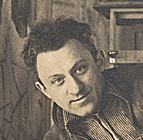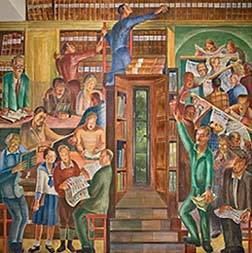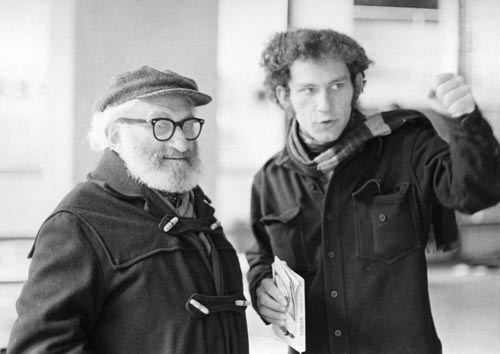Known for Muralist Website bernardzakheim.com | Name Bernard Zakheim | |
 | ||
Died 1985, San Francisco, California, United States | ||
Bernard zakheim s art
Bernard Baruch Zakheim (April 4, 1898 – 1985) was a Polish-born San Francisco muralist, best known for his work on the Coit Tower murals.
Contents
- Bernard zakheim s art
- Early life and immigration
- Artistic career
- Later life and family
- Art
- Murals
- Turn to sculpture
- Politics and art
- Restoration and exhibitions
- Additional Viewing
- References

Early life and immigration

Zakheim was born to a Hasidic Jewish family in Poland. At the age of 13, he expressed his desire to become an artist and to work with his hands, rather than to continue his religious training as a rabbi. His mother objected and as a compromise Zakheim was sent to a technical training school to become a furniture designer and upholsterer. However, he did not actually give up on his artistic goal; he studied watercolor art privately and then was awarded a scholarship to the Polish National Academy of Fine Art, where he studied drawing, painting, and sculpture.

After fighting in World War I, Zakheim and his wife arrived in San Francisco in 1920, where he lived and worked as a furniture maker in the Fillmore District, then a heavily Jewish neighborhood.
Artistic career

In the early 1930s, he committed himself to the preservation and interpretation of Jewish-American life and culture through the making of art. He was one of the organizers of the Yiddish Folkschule on Steiner Street in San Francisco, where he taught children's art classes, and he organized the first "Yiddish art" exhibit in San Francisco.
Around this time, Zakheim was introduced to the muralist Diego Rivera by Lucretia Van Horn. Turning more seriously to mural painting as a form of expression, he traveled to Mexico and studied with Rivera. Back in San Francisco, in 1933 Zakheim helped found the San Francisco Artists and Writers Union, a group of activist artists. The Union lobbied the national government to create a federally funded arts program during the Great Depression. This program became the Public Works of Art Project, and funded Zakheim's work on Coit Tower.
Zakheim's siblings in Poland died as a result of the Nazi Holocaust, and this subject matter became a major focus of his post-war artistic output.
Later life and family
In later life, Zakheim moved out of the city to the rural-agricultural town of Sebastopol, California, where he lived on an old apple orchard and continued his work as a painter.
Zakheim had a daughter, Masha Zakheim (1932 - 2014), who became an art historian and published author, specializing in San Francisco murals and works by Diego Rivera. His daughter Ruth Gottstein (1922 - ) was portrayed in her father's mural at Coit Tower, and was an activist for the restoration of the Coit murals.
Zakheim's son, Nathan Zakheim, has been an expert in mural restoration for most of his career. He was responsible for restoring many important murals, including a WPA-era mural at San Diego State University, one of Edward Biberman’s iconic murals, and some of his own father's work.
Art
Contemporaries described Zakheim's style as "bold, clean, and honest".
Murals
Zakheim's best-known work is the mural "Library" in the Coit Tower, portraying men reading newspapers and books. The fresco was painted in 1934 as part of the larger Coit Tower mural project, which Zakheim also helped organize and oversee. The work reflects Zakheim's own political orientation, as a then-member of the Communist party. For example, fellow artist John Langley Howard reaches for a copy of Das Kapital. It also reflected specific news events happening at the time — one of the newspaper headlines says "Local Artists Protest Destruction of Rivera's Fresco", referring to the destruction of Diego Rivera's "Man at the Crossroads" the year before. Because of this, the mural caused local controversy, with the San Francisco Examiner publishing a photo of the mural under a hammer and sickle (which was not part of Zakheim's design), leading to a temporary stoppage of work and locking of the building before the murals were eventually allowed to be seen by the public.
Zakheim also painted two large frescoes at the University of California, San Francisco, titled "The History of Medicine in California". These received national attention, including a mention in Time magazine. Considered controversial, these were papered over during the late 50s, and later restored by Zakheim's son. In this period he also painted a mural (titled "The Jewish Wedding" or "The Wedding Ceremony") at the San Francisco Jewish Community Center. Another set of murals were painted at the Alemany Hospital in San Francisco's Outer Mission.
Turn to sculpture
In 1966, Zakheim created six wooden sculptures for one of the first Holocaust memorials in the United States, now displayed at Mount Sinai Memorial Park Cemetery in Los Angeles.
Politics and art
Later in life, some commissions were allegedly rejected in part because of his left-leaning politics. However, rather than abandon the political subtexts that informed his art, Zakheim advocated that artists should openly espouse their social and religious beliefs within their works. For example, he was a friend of the science fiction author Frank Herbert, and, according to Herbert's biography, he influenced Herbert's work by encouraging him to include political and religious messages in his books.
Restoration and exhibitions
A number of Zakheim's works have been restored since his death, including the UCSF and JCC murals referenced above, as well as two Depression-era works in Texas. Two posthumous exhibitions of his work have also been held, in 2009 in Los Angeles and in 2010 in San Francisco.
